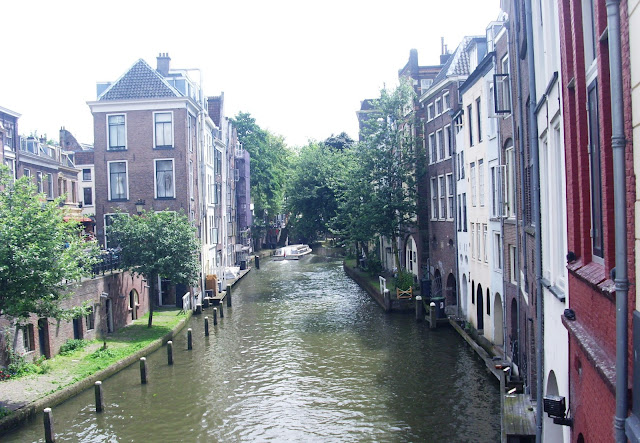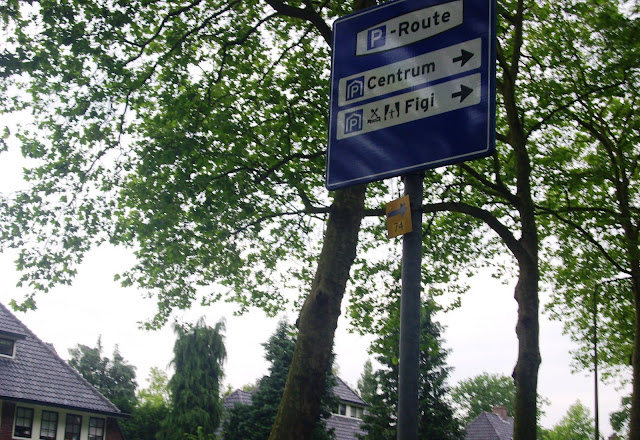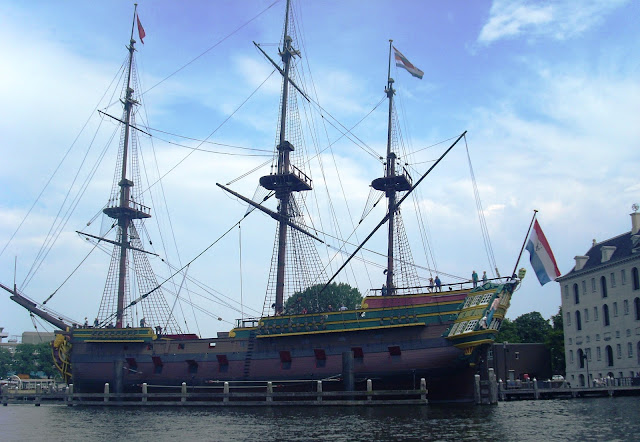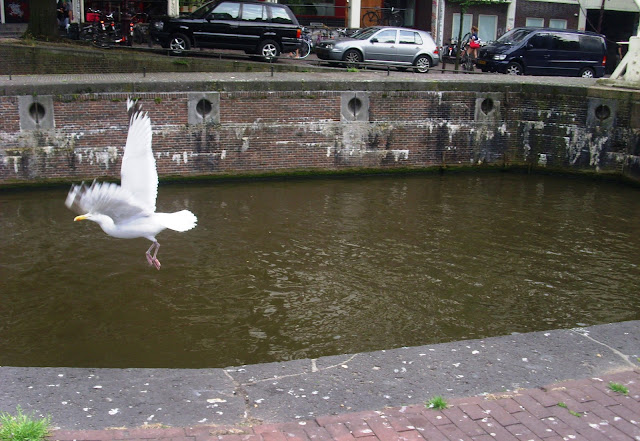 |
| Hagia Sophia Museum in Istanbul, Turkey |
I went to Istanbul because of a World-meeting Congress in the field of Pharmaceutics, where I had the possibility to present my research done at that time. One day after my presentation I had the possibility to visit the Hagia Sophia.
Once upon a time a Byzantine Church, now a museum, the Hagia Sophia stands a top the first hill of Constantinople at the tip of the historic peninsula, surrounded by the waters of the Sea of Marmara, the Bosphorus and the Golden Horn on three sides.
 |
| The entrance to the Hagia Sophia Museum |
It was in a beautiful location, but a bit of a hassle to find the way to the entrance, since there were a lot of reparations being done on the streets and our taxi driver was one of those, who would run you into circles, just for the extra miles. However, all aside, we finally entered the location. Instantly a feeling of peace surrounded me.
 |
| Waiting in line in front of the walls of Hagia Sophia Museum |
It was apparent that this place was full of mysteries and that intrigued me. I wish I had payed more attention before entering the museum, because just around the corner there was a small wooden shop offering headphones that would assist you, just as a cicerone would, for just 10 euros. Oh, well...
 |
| Secret Chambers in Hagia Sophia |
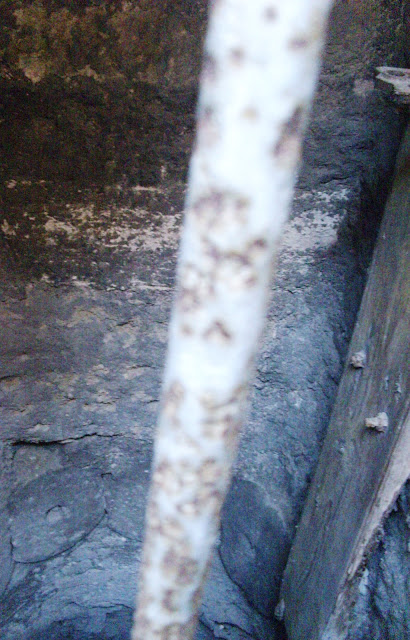 |
| A very deep and dark tunnel like hole in the underground labyrinths of Hagia Sophia |
I could not see the end of this tunnel, surely filled with secrets I can only imagine...
 |
| Underground Hagia Sophia |
Hagia Sophia is the only building in the world designed as a great church, not to have extensive and well-explored underground areas, whether they be crypts, burial chambers or catacombs. This pics were taken before entering the museum.
 |
| Burial remains in front of the Hagia Sophia Museum |
 |
| Careful not to fall, he he |
This is also the only building in the world that has altogether symbolism from Paganism, Christianity and Sunni Muslims. To be honest I felt that the restorations left a lot to desire... When visiting Hagia Sophia, the neglect due to the water damage and decay that exists in the building is apparent...
 |
| View of the magnificent Hagia Sophia Dome |
Most of the Christian features were removed but many others were still there, together with some pagan symbols that we can often find in churches (see this colons are filled with pagan symbols) .
 |
| Christian and Muslim symbols overwritten |
Here the underneath cross can easily be distinguished. Also in the pictures below the efforts for the metamorphosis of the church into a mosque are evident.
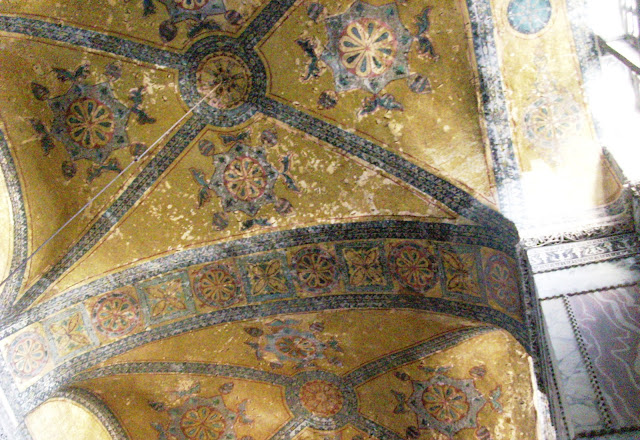 |
| Islamic Art in Hagia Sophia |
 |
| Under the Islamic Art the Christian Symbols can be clearly seen |
 |
| Hagia Sophia |
 |
| Marbles at Hagia Sophia |
Actually it would undoubtedly be a very significant gesture from the Turkish government to return Hagia Sophia to its original Christendom today, but of course that can never be...As a Museum, this structure must remain a testimony to its past, Pagan, Christian and Muslim alike, standing to tell a story, in its structure and stones.
Another thing that caught my eye were the massive caliphs on the Dome. They are pretty controversial because of their over-bearing size. Here is one of them.
 |
| A view of the caliphs and the Hagia Sophia Dome |
One reason for not removing the caliphs is said to be because of their size and that they would have to be destroyed in order to be removed. While a balance is attempting to be made between Christian and Muslim Art, the over-bearing designs of the caliphs strikes a person as soon as they walk into the main part of the structure. Is this a balance or just a statement of superiority? This is surely open to interpretation...
 |
| Uncovered treasures in Hagia Sophia, awaiting to see the light. |
Even though I somehow feel grateful that this magnificent building wasn't destroyed, may be because of the religion and mysticism surrounding it, a careful eye would clearly see that there are so many uncovered jewels underneath the first facade... In the above image, is it me or can you too see a manlike form underneath the deterioration?
Another issue is the alleged mosaic of Christ as Master of the World under the Islamic calligraphy on the Dome. It is unknown with any degree of certainty if this mosaic truly exists. If restoration efforts were undertaken to restore this mosaic, and the Islamic art, covering it was destroyed, what would happen if the mosaic was not there?
 |
| Interior view of the Hagia Sophia dome and the angels surrounding it. |
But on the other hand in this image it is shown the interior view of the dome. Surely the Angels would not have been placed to surround an empty dome, would they?...
 |
| Angels with covered faces in Hagia Sophia |
The faces of these angels are mostly covered (in my knowledge in the Islamic Art it is forbidden to draw faces), but there is one of them, whose face was uncovered in 2010. A seraph most likely, since it has with 6 wings and that no one has set eyes on its face for more than 160 years...It is shown in the image below.
 |
| The face of the seraph, finally sees the light after more than 160 years |
 |
| View of the mosaic from below |
The Archangel Gabriel was also there. It was like he showed his face from the nothingness near him, as to say, there is more in the unseen then in the known. But sometimes it is better to be in the mystery, in the unknown...I am sure you get what I mean...
 |
| Archangel Gabriel mosaic at Hagia Sophia |
 |
| View of the Archangel Gabriel mosaic from another angle |
Some of the symbolism in Hagia Sophia was adopted from the Paganism, as I said in the beginning. For example, the iconography of Virgin Mary and Jesus come from the ancient Egyptian tradition. They are said to be the representation of Goddess Isis and Horus. The halo refers to the God Sun, known as Ra in ancient Egyptian mythology, as depicted in the picture below.
 |
| Iconography of Virgin Mary and Jesus as the representation of Goddess Isis and Horus |
A representation of tridents and dolphins, indicating some form of worship to Neptune/Poseidon and a reference to Atlantis is shown on this panel.
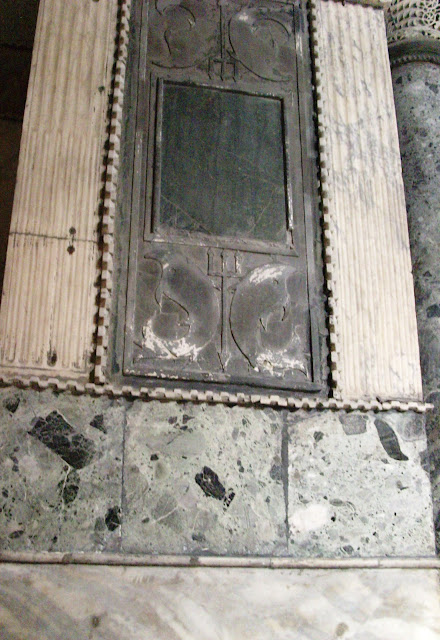 |
| Pagan symbols in Hagia Sophia. Dolphins and tridents. |
On each column on the upper gallery there is a capital with monograms. In some of them it is represented the Ankh (the Egyptian key of life) and a Freemasonry symbol. Who put these symbols up there? It’s still a mystery... Interesting isn't it? Next time you visit a historic place keep an eye for the Pagan symbols...
 |
| Freemasonry symbols in the colons of Hagia Sophia |
 |
| Colons filled with monograms in Hagia Sophia |
At last here is the circle, where the Emperors would be enthroned... I wanted to get in the middle of the circle, but it was strictly forbidden. Apparently if you are not an Emperor or a cleaner you can not get past security, he he...
 |
| The circle, where the Emperors would be enthroned in Hagia Sophia |
The experience in Hagia Sophia was an unforgettable one. It was a very cold place, where time flies by. I have stayed there for approximately 6 hours, without even noticing it. Below are some other pics worth sharing. If you are like me, you sure enjoy photos.
 |
| Mosaics in Hagia Sophia |
 |
| Mosaics on one very high door in the magnificent Hagia Sophia |
 |
| Cat sleeping inside the Hagia Sophia Museum |
As you can see in this last pic there is a kitty cat sleeping comfortably. I called her twice, but she was quite lazy and responded by just wigging her tail as to say 'leave me in peace'.
I would definitely advice you to visit Hagia Sophia, if the opportunity arises. The atmosphere there speaks louder then any words. It is a magnificent place worth seeing. After the visit I suggest a boat ride in the Marmaris sea...From the Hagia Sophia Museum it is just a 15-20 minutes walk, to get to the seaside.
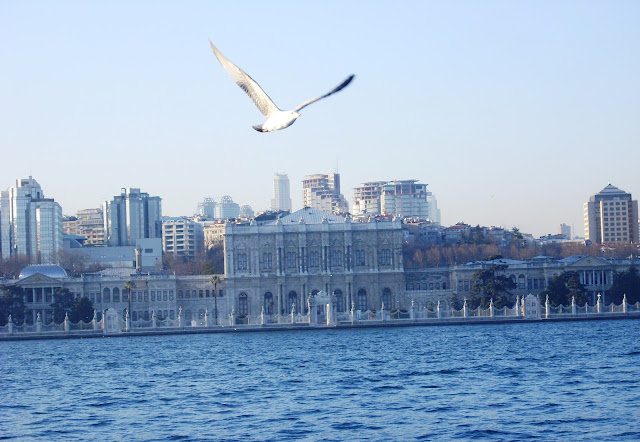 |
| View from a 45 minutes boat travel in the Marmaris sea |
I hope you enjoyed this first post... Best wishes!













